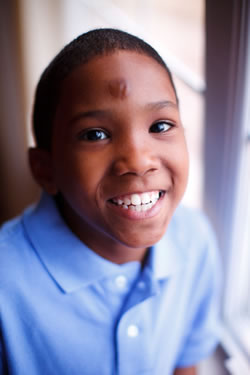It took two tellings before Joslyn Allbritton accepted a surgeon’s assurance that her 9-year-old son, Romel, would have only one tiny scar in his belly button after his gallbladder was removed. “Are you sure?” she asked CHKD pediatric surgeon Robert Obermeyer.
Dr. Obermeyer and his CHKD partners had recently started using a device that allows them to perform complex surgeries through a single incision less than half an inch long.
“Traditional gallbladder removal requires four significant incisions,” Dr. Obermeyer explains. “This device allows us to do the entire procedure through a single incision hidden in the belly button.”
Romel, who has sickle cell disease, is no stranger to CHKD. The hospital and outpatient centers have given Romel superb care since his birth, Joslyn says, except for a brief period when they lived in Atlanta. Last year the family moved back to  Virginia Beach specifically so their son could be treated again at Children’s Hospital.
Virginia Beach specifically so their son could be treated again at Children’s Hospital.
Among the complications of sickle cell disease is an increased risk of gallstones. When sickle-shaped blood cells break down, they leave debris that collects and hardens in the gallbladder, forming stones that can block the flow of bile and cause severe pain. After Romel doubled over with abdominal pains one morning, his mother brought him to CHKD, where an ultrasound revealed the gallstones.
During Romel’s surgery, Dr. Obermeyer inserted a fiber-optic camera, a dissector and a retractor through a collapsible sleeve of the device, which passed through the belly-button incision. Using the camera to direct him, Dr. Obermeyer guided the surgical instruments inside, clamped off the cystic artery and duct, and removed the gallbladder. It took just over an hour.
Dr. Obermeyer and his partners now use the same single-incision laparo-endoscopic procedure for other select operations, part of CHKD’s continuing effort to reduce the risk, impact and scarring of surgery.
Recovery time is comparable to traditional surgery, but with fewer incisions the result is less pain. “While the reduction of pain is obviously important,” he adds, “parents and patients are grateful that the scars are barely visible.”
After the bandage came off, Joslyn watched Romel hunt for the scar. Finally, he had to ask, “Where did he do it?”
This story was featured in the Fall 2011 issue of KidStuff, a publication of Children's Hospital of The King's Daughters. Click to read more patients' stories.